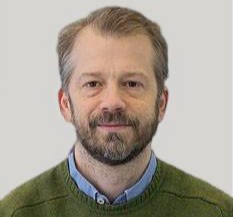Dr. Enrique Cánovas Díaz
Enrique Cánovas graduated on Applied Physics at Universidad Autónoma de Madrid (2002), after that, he realized a two-years master of specialization at Universidad de Valladolid working on the spectroscopic characterization of native and operation-induced defects in high power laser diodes. From 2004 to 2006 he made a second master of specialization at Universidad Politécnica de Madrid (Institute of Solar Energy, IES); training focus was on the fabrication, characterization and optimization of solid state solar cells. After that he joined the group of Prof. Martí and Prof. Luque at IES, where he completed PhD studies on the spectroscopic characterization of novel nanostructures aiming ultra-high-efficiency solar cells. His PhD studies included two placements (covering 9 months in total) at Lawrence Berkeley National Laboratory (USA - with Prof. W. Walukiewicz) and Glasgow University (Scotland - with Prof. Colin Stanley). Between 2010 and 2012 he worked as a postdoc with Prof. M. Bonn at FOM Institute AMOLF (Amsterdam - The Netherlands), there he focused on the characterization of carrier dynamics in sensitized solar cell architectures. From 2012 to 2018 he lead the Nanostructured Photovoltaics group in the Department of Molecular Spectroscopy at the Max Planck Institute for Polymer Research (Mainz, Germany). Since April 2018, Enrique Cánovas works at IMDEA Nanociencia where he leads the Nanostructured Photovoltaics; research interests cover all aspects of photovoltaics and nanotechnology and charge carrier dynamics.
Research Lines
In the Nanostructured Photovoltaics Group we aim developing solar cell device architectures that exploit the potential of nanotechnology. Our ambition is to unravel and tailor the optoelectronic properties of nanometer sized semiconductors for obtaining low cost-high efficiency solar cell and fuel devices. Our approach is multidisciplinary, combining fundamental research on sample's physico-chemistry with solar cell device engineering.
Fundamental understanding and eventual engineering of charge carrier transfer and transport at the nanoscale is one of our core competences and research interests. Our interest aligns with the fact that charge carrier dynamics determine the photoconversion efficiency of any solar converter. As nanoscale objects are defined by large area-to-volume ratios, surface chemistry play a pivotal role on object's functionality; furthermore, quantum confinement of charge carriers at the nanoscale make object's optoelectronic properties to be strongly tunable with structure. In this respect, establishing neat correlations between surface chemistry, structure and charge carrier dynamics taking place in nanostructured systems represent one of the most significant leading contemporary topics in material science.
Interfacial charge carrier dynamics in donor-acceptor systems
Controlling electron transfer in nanostructured donor-acceptor systems is a key target for developing high efficiency photovoltaic and photocatalytic devices. We are interested on unraveling the fundamentals of these critical processes at quantum dot-metal oxide interfaces (see e.g. ACS Nano 11(5), 4760, 2017; JPCL 10, 1431, 2019).
Charge transport in nano-structured systems
Efficient charge carrier motion is a prerequisite in order to exploit nanostructured systems in solar energy conversion schemes. The nature of charge transport can be unraveled by THz spectroscopy, which is capable of characterizing the photoconductivity of a sample with sub-ps resolution and in a contactless fashion. By this method we have been able to demonstrate free carrier (band-like) charge transport in hybrid perovskites (JPCL 6(24), 4991-4996, 2015) and metal organic frameworks (Nature Materials 17, 1027-1032, 2018).
Third generation photovoltaics
A conventional 2-level solar absorber suffers from two intrinsic major energy loss channels: (1) its inability to absorb photons with energy less than the material absorption threshold and (2) the waste of photon energy when photons with energies above the absorption threshold are absorbed (cooling). Part of our research efforts are focused on engineering nanostructured systems for diminishing those energetic losses towards breaking the 30% Shockley-Queisser limit photoconversion efficiency barrier (see e.g. JPCL 8(12), 2654 (2017); Nano letters 18(8), 5111, 2018).
Relevant publications
Chemisorption of atomically precise 42-carbon graphene quantum dots on metal oxide films greatly accelerates interfacial electron transfer. Peng Han, Ian Cheng-Yi Hou, Hao Lu, Xiao-Ye Wang, Klaus Müllen, Mischa Bonn, Akimitsu Narita and Enrique Cánovas*. The Journal of Physical Chemistry Letters 10, 1431 (2019).
High-mobility band-like charge transport in a semiconducting two-dimensional metal–organic framework. Renhao Dong, Peng Han, Himani Arora, Marco Ballabio, Melike Karakus, Zhe Zhang, Chandra Shekhar, Peter Adler, Petko St. Petkov, Artur Erbe, Stefan C. B. Mannsfeld, Claudia Felser, Thomas Heine, Mischa Bonn, Xinliang Feng* & Enrique Cánovas*.
Nature Materials 17, 1027-1032 (2018).
Direct observation of mode-specific phonon-band gap coupling in methylammonium lead halide perovskites. Heejae Kim, Johannes Hunger, Enrique Cánovas, Melike Karakus, Zoltán Mics, Maksim Grechko, Dmitry Turchinovich, Sapun H. Parekh & Mischa Bonn. Nature Communications 8, 687 (2017).
Dipolar Molecular Capping in Quantum Dot-Sensitized Oxides: Fermi Level Pinning Precludes Tuning Donor-Acceptor Energetics. Hai I. Wang, Hao Lu, Yuki Nagata, Mischa Bonn and Enrique Cánovas* ACS Nano 11(5), 4760 (2017).
Tuning electron transfer rates through molecular bridges in quantum dot sensitized oxides. H. Wang, E. R. McNellis, S. Kinge, M. Bonn and E. Cánovas*. Journal of the American Chemical Society 137 (16), 5602-5609 (2015).
Boosting power conversion efficiencies of quantum-dot-sensitized solar cells beyond 8% by recombination control. K Zhao, Z Pan, I Mora-Seró, E Cánovas, H Wang, Y Song, X Gong, et al. Journal of the American Chemical Society 137 (16), 5602-5609 (2015).
Phonon–electron scattering limits free charge mobility in methylammonium lead iodide perovskites. M Karakus, SA Jensen, F D’Angelo, D Turchinovich, M Bonn, E Canovas*. The journal of physical chemistry letters 6 (24), 4991-4996 (2015).
Interplay between structure, stoichiometry and electron transfer dynamics in SILAR-based quantum dot-sensitized oxides. H. Wang, I. Barceló, T. Lana-Villareal, R. Gómez, M. Bonn and E. Cánovas*. Nano Letters, 14(10), 5780-5786 (2014).





